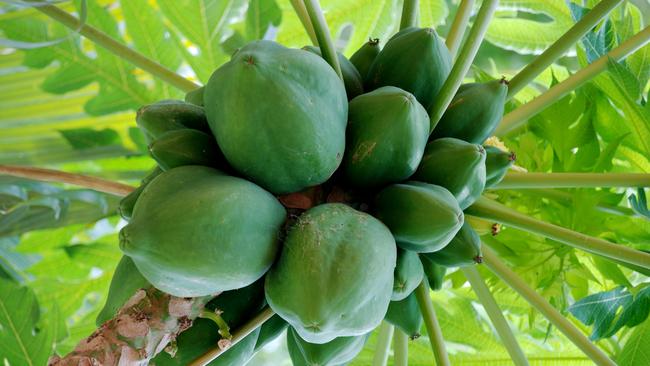Paw your heart out to get the best crop of pawpaws
Are spots on pawpaws driving you insane? Banishing them from foliage and fruit requires selection, nutrition and preventative action.

U on Sunday
Don't miss out on the headlines from U on Sunday. Followed categories will be added to My News.
Are spots on pawpaws driving you insane? Banishing them from foliage and fruit requires selection, nutrition and preventative action. Put in the effort or wash your hands of pawpaw growing.
Pawpaw, papaw or papaya (Carica papaya) are botanically the same. Some commercial growers use pawpaw/papaw for yellow-flesh varieties and the more exotic sounding papaya to distinguish red-flesh types.
Consumers have a love/hate relationship with pawpaws – some cannot get enough of them, delighting in the flavour and widely acknowledged health and digestive benefits of consuming the fresh fruit. But growers and Griffith University have embarked on a non-GM fruit improvement program to attract the sizeable proportion of the population who think pawpaws smell like sweaty socks and taste even worse.
Pawpaw seems like the perfect suburban fruit tree. It doesn’t require much room, bears fruit in the first year, and is prolific.
When it comes to pollination, there are three main types.
Male pawpaw trees produce metre-long stems bearing almost exclusively pollen-producing male flowers. An estimated 5 per cent of males bear self-fertile hermaphrodite/bisexual flowers (pollen and ovary) that produce characteristically torpedo-shaped fruit. Seeds from the fruit of male trees are viable, producing male and female offspring in a 3:1 ratio.
Female pawpaw trees produce ovary-bearing female flowers. They need pollen from another tree to set fruit. Pollen is carried by wind and insects, particularly moths.
Hermaphrodite or bisexual trees are
self-fertile. They bear flowers with pollen-producing anthers, flowers with fruit-producing ovaries, and/or complete flowers with male and female parts – all on the one tree. Pollen transfer is efficient, with high fruit set.
But how do you deal with the dreaded winter black spot? To gardeners, black spot is not one disease but describes a number of fungal and bacterial problems that have a similar appearance.
They affect both foliage and fruit. Disease is prevalent on plants with less natural genetic disease resistance; on nutrient- and water-stressed plants; or in instances where air circulation is poor, sunshine is limited or foliage and fruit remain cold and damp for extended periods.
Beating disease starts with experimenting to find the right plant for your region. Commercial growers increasingly grow disease-resistant tissue-culture plants. These are not yet available to home gardeners, who remain limited to seed-grown plants from nurseries or seed from locally grown fruit. This will not change in the short term.
Ensure plants have full sun, perfect drainage and nutrient-rich soil with a pH of 6.5. Trees are traditionally grown close to buildings (their roots are not invasive), where they benefit from radiated heat and the eaves keep the foliage dry.
Apply fertiliser every month. An organically based fruit tree fertiliser or chicken manure pellets and compost are ideal. Add a sprinkle of sulphate of potash to build disease resistance and improve fruit flavour. Deficiencies of trace elements can be overcome by adding animal manure, compost or a commercial trace element mix.
Preventative spraying for black spot needs to start now and be done regularly. Many gardeners swear by milk spray (1 part full-cream milk to 10 parts water). Copper sprays (cupric hydroxide); wettable sulphur and foliar sprays of liquid silica and potash, as well as general-purpose chemical fungicides, are also available. As you may be dealing with several diseases, one remedy will not necessarily work in all instances.


